WooCommerce Affiliate Tracking: A Complete Guide

Around 81% of brands rely on affiliate programs to drive sales, yet many WooCommerce stores still track commissions manually. This can lead to various errors, lost revenue, and frustrated partners.
Our complete guide shows you how to set up accurate, automated affiliate tracking, so you can grow faster and manage your WooCommerce affiliate tracking smarter.
Why is Affiliate Tracking Important?
Affiliate marketing thrives on data, and affiliate tracking is the system that powers the entire ecosystem. If you are a brand running an affiliate program or a publisher promoting products, tracking ensures that every click, conversion, and commission is accurately accounted for.
Here is why affiliate tracking is important:
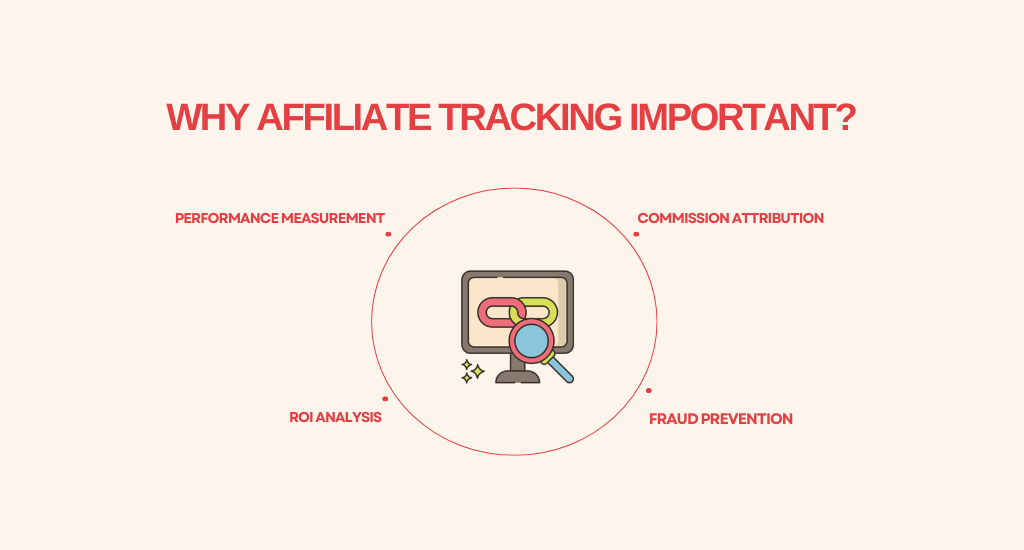
Performance Measurement
Affiliate tracking enables you to precisely measure the effectiveness of your affiliate program. You can identify which affiliates are driving the most traffic, which campaigns are converting, and what types of content are resonating with audiences.
This data helps you double down on strategies that work and adjust those that don’t, ensuring your affiliate program remains efficient and effective.
Commission Attribution
One of the primary roles of affiliate tracking is ensuring fair and accurate commission attribution. When a user clicks on an affiliate link and completes a purchase, the tracking software ensures that the responsible affiliate receives proper credit.
Without this, trust between merchants and affiliates would break down, which leads to disputes and loss of credibility in the program.
ROI Analysis
Affiliate tracking gives you the numbers you need to asses your return on investment (ROI). By comparing how much you are paying in commission against the revenue generated by affiliate-driven sales. With this, you can determine whether or not your affiliate program is profitable.
Detailed tracking helps you allocate your marketing budget more strategically and scale partnerships that deliver the best returns.
Fraud Prevention
Click fraud and cookie stuffing can undermine affiliate programs, which cost brands money and damage relationships. Advanced affiliate tracking systems can detect suspicious activity, such as inflated clicks or duplicate conversions.
This allows you to take proactive measures, blocking fraudulent affiliates or flagging questionable transactions, to protect he integrity and profitability of your affiliate program.
WooCommerce Affiliate Tracking Methods
Now that you have a clear overview of why affiliate link tracking is important. Next, we will explore WooCommerce affiliate tracking methods.
There are four primary approaches to effectively tracking and managing affiliate links. We will begin by focusing on solutions specifically for WooCommerce and WordPress users. However, many of these techniques can also be applied to EasyCommerce, making them a great fit for those considering alternatives to WooCommerce.
Let’s take a look at the primary approaches.
1. Using a Link Clocking Plugin

Affiliate links can be long, messy, and a little intimidating, especially when they are packed with tracking code, campaign IDs, and referral tags. To overcome this, you can cloak your affiliate links.
Instead of sharing a complicated URL like this:
example.com/product/B09XK5F2LQ/ref=affiliate123?tag=mydeal&campaign=holiday2025You can make it up into something like this:
example.com/deals/smartwatch It’s much better, right?
By cloaking your affiliate links, you make them look cleaner, more professional, and easier to trust and click. But to better learn the benefits of cloaking affiliate links, check out how to cloak affiliate links in WooCommerce.
2. Using UTM Parameters
An affiliate link cloaking plugin is great for making affiliate links look clean and tracking basic clicks. But if you really want to understand where your traffic is coming from, UTM parameter is another way.
With UTM tags, you can add extra details to your affiliate links. This method can help you track exactly which platform, channel, and campaign are driving results.
To create a tracked link, you have to go to the Campaign URL Builder. Just paste your affiliate URL and fill out the key fields.
- Website URL
- Campaign Source
- Campaign Medium
- Campaign Name

Remember: UTM parameters are case-sensitive, so stick to lowercase and keep your naming consistent to avoid messy reports.
Here is the easiest way to track WooCommerce affiliate links using Google Analytics (GA4). Go to Reports > Life Cycle > Acquisition > Traffic Acquisition.
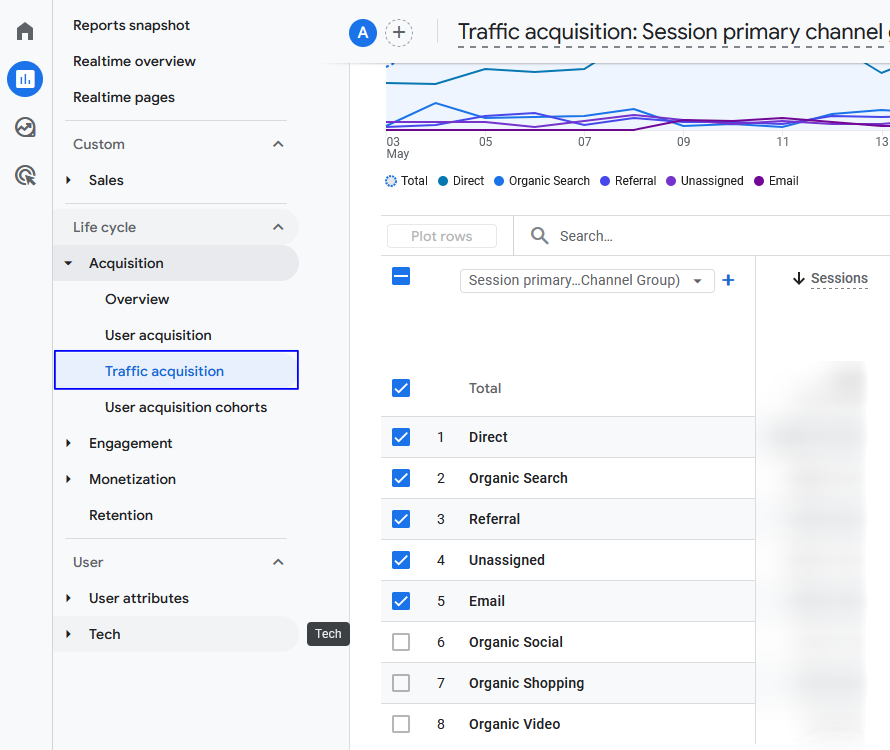
Then, change the default column from “Session default channel group” to “Session source/medium”. This lets you see exactly which source and medium combinations (like Instagram/bio) are bringing in traffic, clicks, and conversions.
3. Tracking Link Performance in Google Analytics
There is another method to track the WooCommerce affiliate link. It is also important to monitor affiliate link clicks that happen on your website. Google Analytics lets you do this using enhanced measurement and a simple custom event setup.
Step 1: Enable Enhanced Measurement
Log in to your GA4 account, and then go to Admin and click on Data Streams under the property section.
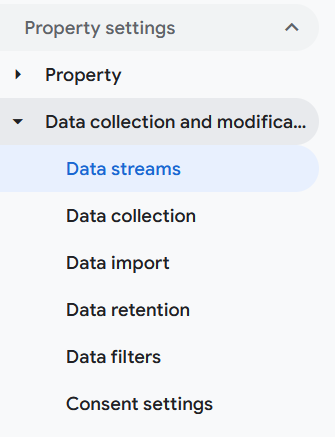
Choose your website’s data stream, click the gear icon next to Enhanced Measurement. And make sure Outbound Clicks is also enabled.
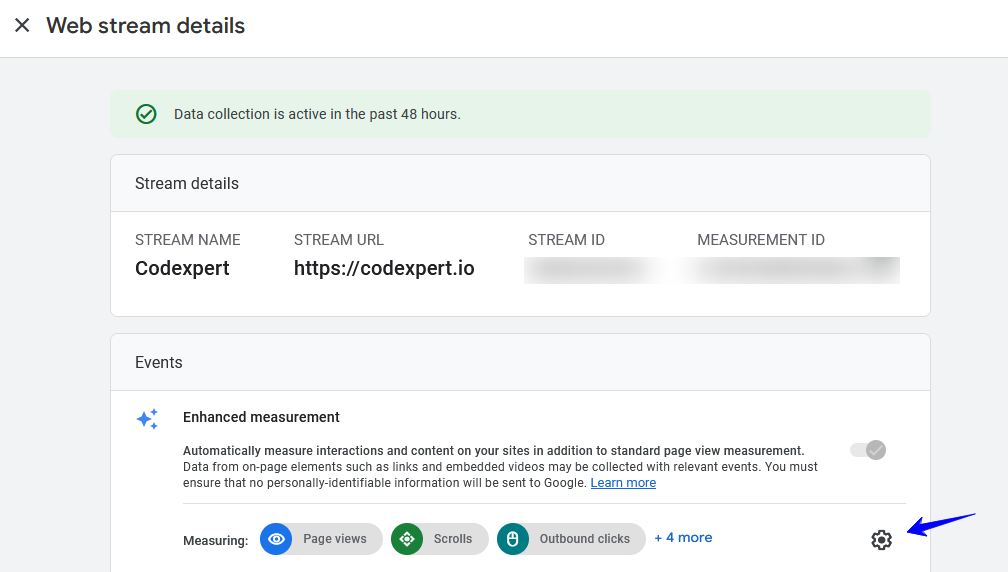
When this is enabled in GA4, it will automatically track when someone clicks a link that leads to another website, including your affiliate links.
Step 2: Create a Custom Event for Affiliate Links
To track only affiliate clicks, go back to Admin > Events, click Create Event, and name the event as generate_lead
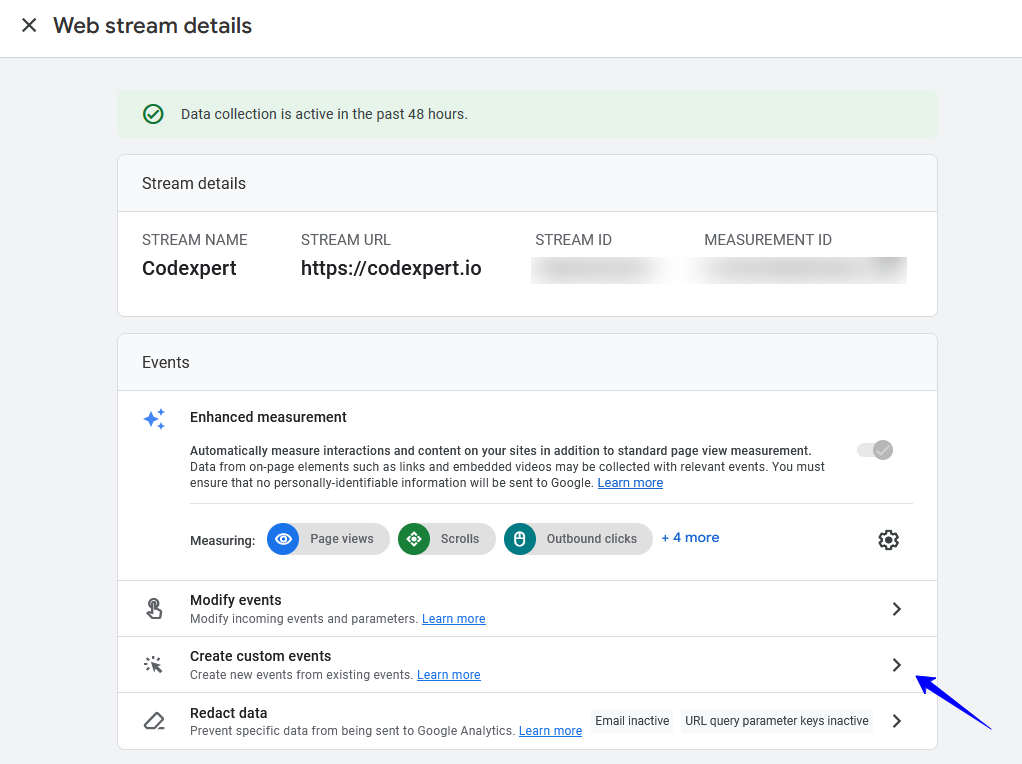
Now you have to set two conditions for this. You will find Matching Conditions where you can set the Parameter as event_name, Operator as equals, and the Value as clicks. For the next condition –
- Parameter – link_urls
- Operator – equals
- Value – /affiliate-domain/
If you use multiple affiliate programs, you can include several domains by separating them with a pipe symbol. For example: easycommerce. dev | pluggable.io | codexpert.io.
Step 3: Track Your Results
After saving your custom event, go to Reports > Engagement > Events to find the generate_lead event and see metrics like total clicks and number of users.
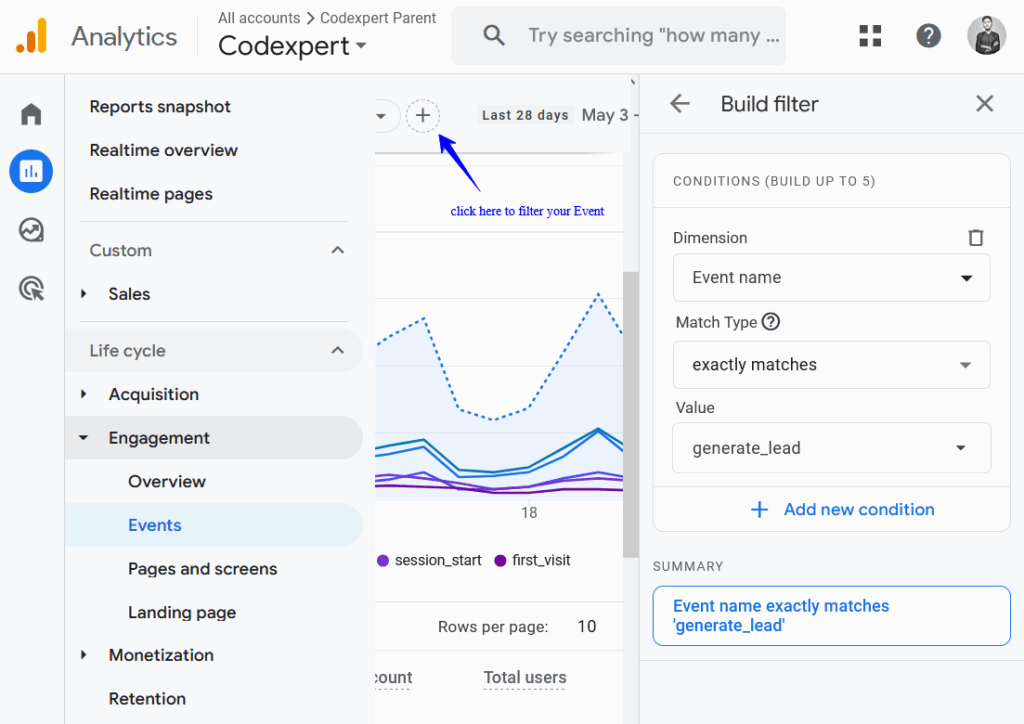
To focus only on affiliate activity, filter the report to show only the generate_lead event.
4. Using Dedicated Affiliate Tracking Tools
If you think of this as an extra burden and have many other tasks to do, this method is for you. Using a dedicated affiliate tracking service offers more advanced features like real-time click tracking, commission management, conversion attribution more.
Here are some of the platforms like Impact, PartnerStack, and Tapfiliate. These tools are essential if you want WooCommerce affiliate tracking, run a full affiliate program, or need more accurate performance data across multiple platforms.
But these platforms are not fully free to run your WooCommerce affiliate tracking.
In the next step, we will learn how you can set up and track WooCommerce affiliate link using a free WooCommerce affiliate plugin.
How to Set up and Track WooCommerce Affiliate Links
Now that you’ve explored various methods for affiliate tracking in WooCommerce. In this section, we’ll guide you through setting up and tracking affiliate links using a dedicated WooCommerce affiliate plugin.
1. Choose an Affiliate Tracking Plugin
Go to your website dashboard > Plugins > Add new and search for WC Affiliate. Click on the install button, and after that, activate it.

2. Set Up Your Affiliate Program
When the plugin is activated, navigate to the setup wizard. On the setup wizard page, you have to create your Affiliate Dashboard page. Select Create a new page and click on the Next button.
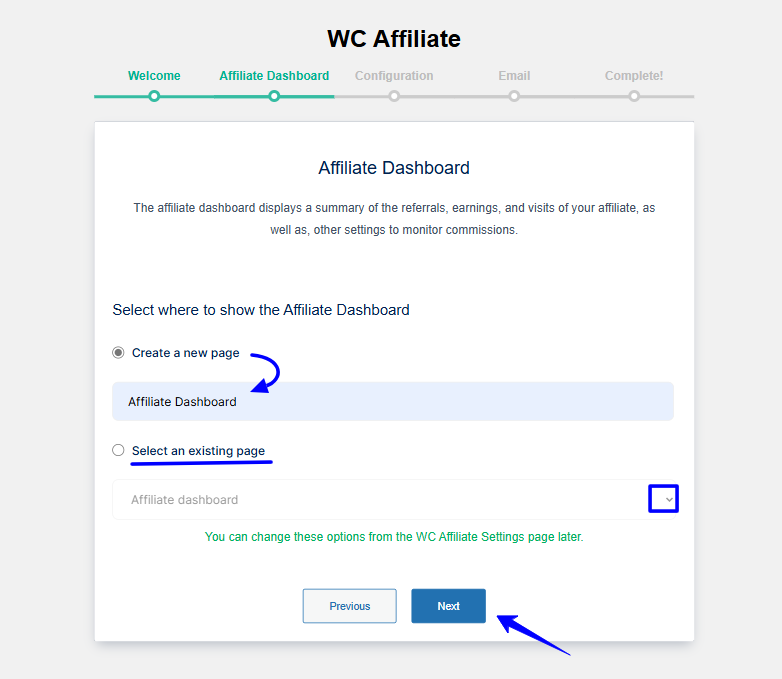
On the next page, you have to configure your affiliate program settings. Here, you have to set the affiliate commission base, their commission rate, and the cookie expiry.
You can choose option from the dropdown for personalized settings.
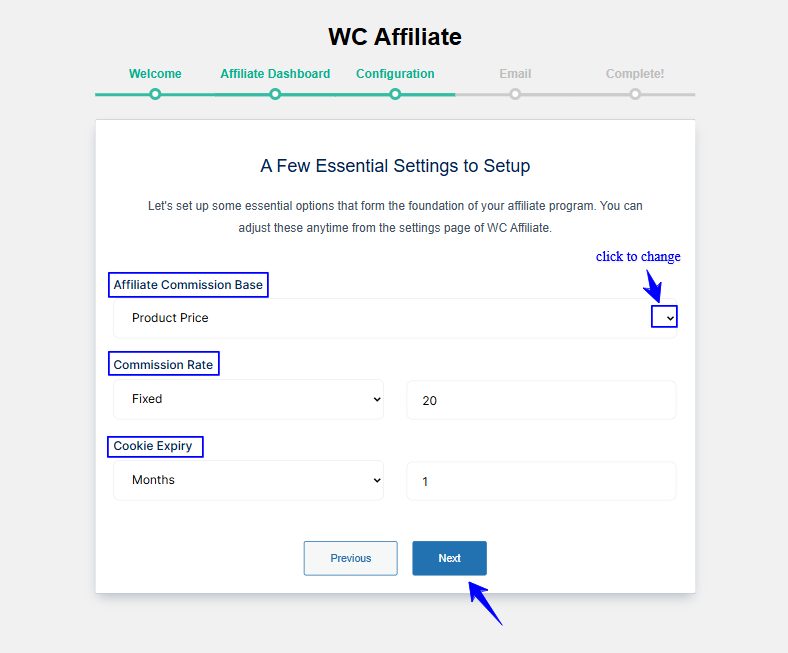
When you are complete with all the steps, click on the finish button to continue to generate affiliate tracking links for your WooCommerce store.
3. Generate Tracking Links
To generate tracking links for your WooCommerce store, now go to your Affiliate Dashboard page > URL Generator. Here, provide your desired URL in the empty field and click on the Generate button.
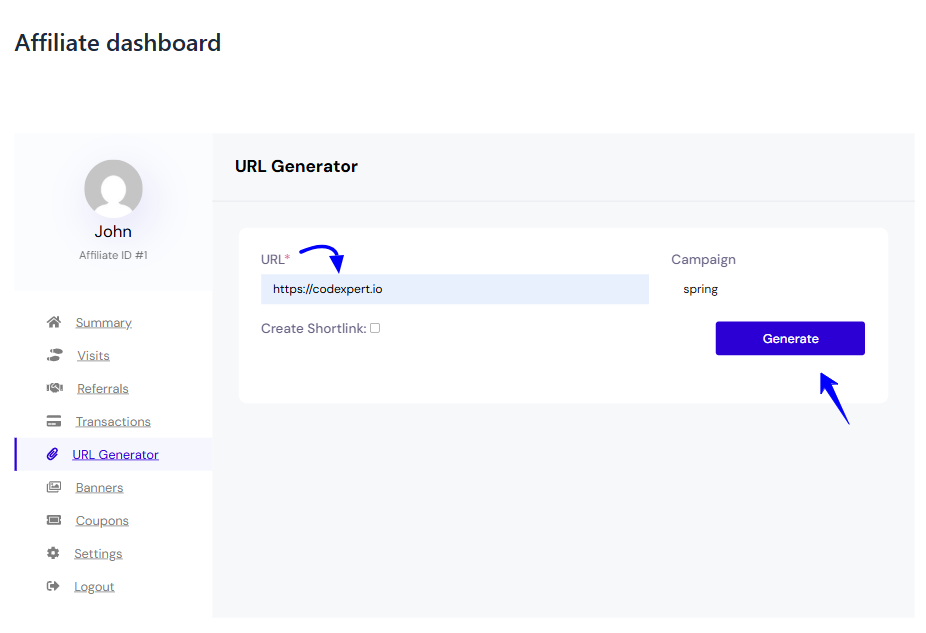
If you want to generate a shortlink/cloaked affiliate link, you can follow the article I mentioned earlier in this article.
4. Monitor and Analyze Performance and KPIs
Regularly reviewing your affiliate tracking reports is essential to assess performance, monitor conversions, and identify areas for improvement. As you analyze your data, focus on key performance indicators such as:
- Conversion rate
- Click traffic
- Earnings per click
- Number of sales
- Total revenue, and
- Number of active affiliates.
It’s also important to track the percentage of new customers generated through affiliates, the average order value, and the cost per affiliate or sale.
Keeping an eye on these metrics will help you better understand what’s working, where to optimize, and how to improve the overall effectiveness of your affiliate marketing efforts.
5 Best Practices for WooCommerce Affiliate Tracking
Now that you have all your tools and affiliate program set up, let’s look at some best practices to follow when it comes to WooCommerce affiliate tracking –
Keep It Transparent
Your affiliates shouldn’t have to guess how your tracking works. Be upfront about how links are tracked, when commissions are counted, and what counts as a valid sale. Clear expectations build trust and happier, more loyal partners.
Test Your Links Often
There’s nothing worse than a broken link. Make it a habit to test your affiliate links regularly to make sure they’re all working as expected. A quick check can save you from lost sales and frustrated affiliates.
Stay on the Right Side of the Rules
Affiliate marketing comes with its fair share of regulations, think FTC disclosures and GDPR. Make sure you (and your affiliates) follow the guidelines. It’s not just about staying legal, it’s about building a reputable program.
Talk to Your Affiliates
Don’t just send them a link and disappear. Share updates, check in, offer new content or promotions, and they’ll appreciate it. Strong communication leads to stronger performance.
Keep Learning
Affiliate marketing moves fast. New tracking tools, privacy updates, platform changes, there’s always something new. Stay curious, keep learning, and make sure your program evolves with the times.
Final Words
Affiliate marketing can be a powerful way to grow your online store, but only if your affiliate tracking is accurate and reliable. Manual methods often cause errors, lost revenue, and frustrated partners.
By using the right tools and strategies, like link cloaking, UTM parameters, dedicated plugins, and analytics, you can simplify tracking, improve transparency, and build stronger affiliate relationships!
Frequently Asked Questions(FAQs)
Q. How can I set up affiliate tracking in WooCommerce?
You can set up tracking by installing an affiliate plugin like WC Affiliate.
- Install and activate WC Affiliate on your website
- Configure basic settings from the setup wizard.
- Generate affiliate links.
You can also use UTM parameters and Google Analytics for detailed tracking.
Q. What are effective methods to track affiliate links?
Effective methods include link cloaking plugins for clean URLs, adding UTM parameters for campaign tracking, enabling enhanced measurement in Google Analytics, and using dedicated affiliate tracking platforms.
Q. How do I prevent fraud on the WooCommerce website?
Prevent fraud by using advanced tracking tools that detect suspicious clicks, regularly test your affiliate links, and set clear rules for commissions to maintain trust with your affiliates.
Q. What is the best WooCommerce affiliate plugin for WordPress?
WC Affiliate is a great option for small businesses – a full-featured plugin built specifically for WooCommerce. It also works well with EasyCommerce, a modern ecommerce plugin for WordPress.
Subscribe to Our Newsletter
Get the latest WordPress tutorials, trends, and resources right in your inbox. No Spamming, Unsubscribe Anytime.

Thank you for subscribing to our newsletter!
Table of Content
- Why is Affiliate Tracking Important?
- Performance Measurement
- Commission Attribution
- ROI Analysis
- Fraud Prevention
- WooCommerce Affiliate Tracking Methods
- 1. Using a Link Clocking Plugin
- 2. Using UTM Parameters
- 3. Tracking Link Performance in Google Analytics
- 4. Using Dedicated Affiliate Tracking Tools
- How to Set up and Track WooCommerce Affiliate Links
- 1. Choose an Affiliate Tracking Plugin
- 2. Set Up Your Affiliate Program
- 3. Generate Tracking Links
- 4. Monitor and Analyze Performance and KPIs
- 5 Best Practices for WooCommerce Affiliate Tracking
- Keep It Transparent
- Test Your Links Often
- Stay on the Right Side of the Rules
- Talk to Your Affiliates
- Keep Learning
- Final Words
- Frequently Asked Questions(FAQs)
- Q. How can I set up affiliate tracking in WooCommerce?
- Q. What are effective methods to track affiliate links?
- Q. How do I prevent fraud on the WooCommerce website?
- Q. What is the best WooCommerce affiliate plugin for WordPress?













